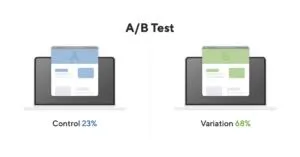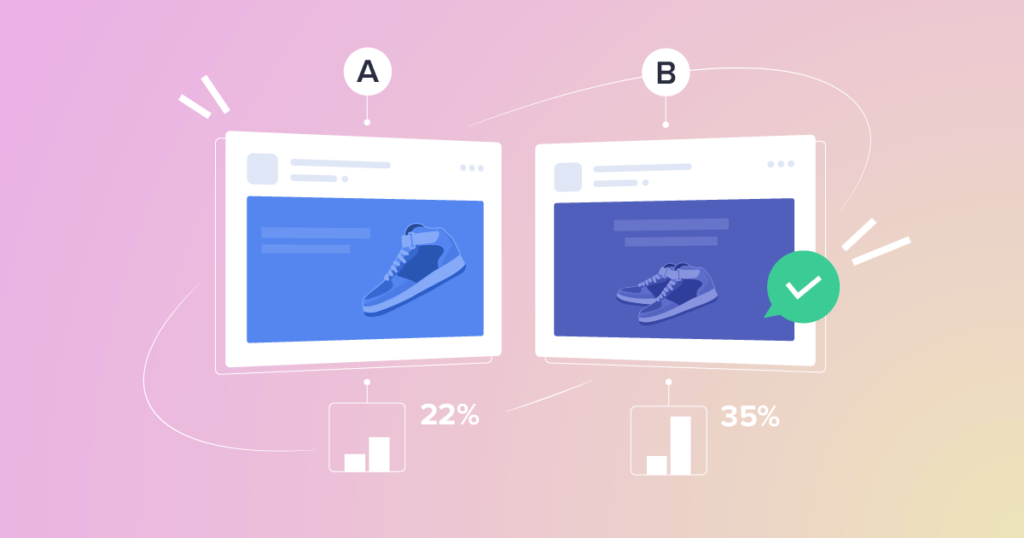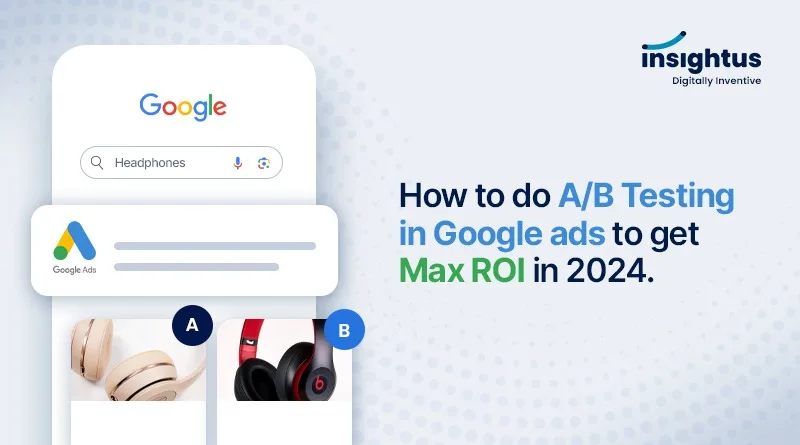In 2024 maximizing return on investment (ROI) from Google Ads campaigns can be difficult. Many advertisers struggle to identify the optimal combination of ad elements for peak performance and conversion.
A/B testing offers a data-driven approach to campaign optimization and boosting profitability. By systematically testing different variations of your ad elements, you can gain valuable insights into what resonates best with your target audience and drives the most desired actions.
What is A/B Testing in Google Ads?
A/B testing, also known as split testing, is a scientific method of comparing two or more variations of an ad element to determine which one performs better. It involves creating a control group, which represents the original version of the ad, and a variant group, which features a modified version. The performance of these groups is then measured against specific metrics to identify the most effective approach.
Key components of A/B testing in Google Ads include:

Image credit: google.com
1. Control & Variant Groups:
- Control Group: This acts as your benchmark, representing the current state of your ad. It allows you to compare any improvements or declines observed in the variant group.
- Examples: The original headline, image, or call to action of your ad.
- Variant Group: This introduces a controlled change to a specific element within your ad. Monitor this group to see how the change impacts performance.
- Examples: Testing a different headline color, replacing an image with a video, or offering a new discount in the call to action.
2. Metrics:
- Choose the right metrics for your goal: Align your chosen metrics with the desired outcome of your A/B test.
- For increasing leads: Track click-through rate (CTR), conversion rate from click to lead, and cost-per-lead (CPL).
- For boosting sales: Focus on conversion rate from impression to purchase, average order value (AOV), and return on ad spend (ROAS).
- Don’t rely on single metrics: Analyze a combination of relevant metrics to paint a holistic picture of performance.
High CTR doesn’t always translate to increased sales, so consider metrics like conversion rate and profitability as well.
3. Statistical Significance:
- Eliminate the “chance” factor: Statistical significance ensures that any observed difference between the control and variant groups is not simply due to random variation in data. Google Ads Experiments platform helps determine statistical significance by providing confidence levels.
- Set the right confidence level: A higher confidence level (e.g., 95%) means a lower chance of the observed difference being random, but may require a larger sample size.
Additional Tips:
- Test one element at a time: Introduce controlled changes to isolate the impact of each element on performance.
- Run tests for an adequate duration: Ensure enough data is collected for statistically significant results, depending on your traffic volume.
- Analyze & adapt: Don’t just gather data; interpret it and adjust your campaigns based on your findings.
By understanding these key components, you can confidently navigate A/B testing in Google Ads and uncover valuable insights to optimize your campaigns for maximum ROI.
Why A/B Testing is More Crucial in 2024:

Image credit: google.com
1. Data-Driven Optimization in the Age of Automation:
- Rise of Performance Max campaigns: In 2024, Google Ads’ focus on automated bidding and campaign management (like Performance Max) puts even greater emphasis on testing and data-driven insights. A/B testing allows you to fine-tune your automated approach and ensure your campaigns are truly optimized for your specific audience and goals.
2. Adapting to the Shifting Sands of User Behavior:
- Dynamic user preferences: Consumer trends and expectations evolve rapidly. A/B testing provides real-time data on what resonates with your audience now, allowing you to continuously update your messaging and creatives to stay ahead of the curve.
3. Conquering the Competitive Landscape:
- Fiercer competition: In today’s saturated digital landscape, every edge counts. A/B testing helps you identify and exploit subtle performance differences, giving you a competitive advantage over rivals who rely on guesswork or outdated strategies.
In 2024, A/B testing isn’t just a nice-to-have; it’s a fundamental tool for survival and success. It empowers you to the full potential of automated campaigns, adapts to a dynamic market, and outmanoeuvres your competitors. By embracing A/B testing, you can transform your Google Ads from a cost centre to a powerful engine for growth in 2024.
A/B Testing Every Facet of Your Google Ads

Image credit: google.com
A/B testing isn’t just for tweaking headlines anymore. In 2024, maximizing your ROI demands a comprehensive approach, testing every element that defines your Google Ads’ impact. Here’s where to turn your A/B testing microscope:
1. Captivating Creatives:
- Images & Videos: A/B test different styles, colours, and compositions. Try animation, product shots, or real-life scenarios.
- Design Elements: Experiment with fonts, layouts, and branding consistency. Does minimalism win, or does a bold approach captivate?
2. Compelling Copy:
- Headlines: Craft catchy attention-grabbers that test emotional triggers, power words, and conciseness.
- Descriptions: Highlight features, benefits, and urgency. See if bullet points outperform paragraphs, or vice versa.
- CTAs: Test action verbs, colors, and placement. Does “Sign Up Now” outperform “Get Started”?
3. Irresistible Offers:
- Promotions & Discounts: A/B test different percentages, expiration dates, and types (free shipping, bonus gifts).
- Value Propositions: Emphasize different benefits. Does convenience trump savings, or is exclusivity the key?
4. Precise Targeting:
- Demographics & Interests: Refine your target audience to reach the right people at the right time. Test age ranges, income levels, and niche interests.
- Keywords: Explore broader or more specific keyword sets. Does long-tail specificity win, or do broader terms drive higher reach?
5. Strategic Placements:
- Search vs. Display: Discover where your audience engages most. A/B test search ads against display networks like YouTube or social media.
- Device Targeting: Tailor ads for mobile, desktop, or specific devices. Is short and punchy best for mobile, or can you engage with longer narratives on desktop?
Suggestions:
- Don’t test everything at once. Start small, isolate variables, and build on your learnings.
- Use statistically significant data to avoid misleading conclusions.
- Don’t be afraid to be bold and experiment! A/B testing thrives on creativity and continuous optimization.
By testing every element from visual storytelling to strategic targeting, you’ll see hidden performance gems and refine your Google Ads into ROI-generating powerhouses. So, dive deep, and test relentlessly – one A/B test at a time!
A/B Testing: Your Arsenal for ROI-Fueled Campaigns

Image credit: google.com
A/B testing isn’t just a concept; it’s a science. To use its full potential in 2024, equip yourself with the right tools and techniques:
1. Your Testing Playground: Google Ads Experiments Platform:
- Built-in convenience: Seamless integration with your campaigns, making setup and monitoring a breeze.
- Automated analysis: Insights on statistical significance and confidence levels, eliminating guesswork.
- Visual reports: Track performance and compare variants with intuitive dashboards.
2. Beyond the Garden Walls: Third-Party A/B Testing Tools:
- Advanced features: Go beyond Google’s offerings with heatmaps, session recordings, and multivariate testing (testing multiple elements simultaneously).
- Integrations: Connect with other marketing tools for a holistic view of your audience and campaigns.
- Customization: Craft bespoke testing experiences tailored to your specific needs.
3. Aiming for the Bullseye: Defining Clear Hypotheses and Objectives:
- What are you testing? Be specific. Are you comparing headlines, audiences, or offer strategies?
- What do you expect to achieve? Define your desired outcome – higher clicks, increased conversions, or lower cost per lead.
- Measure the right things: Align your metrics with your objectives to accurately gauge success.
4. Size Matters: Setting Statistically Significant Sample Sizes:
- Too small, and you’re in the dark. Ensure enough data to draw reliable conclusions that aren’t just random fluctuations.
- Google Ads Experiments helps by suggesting sample sizes based on your campaign traffic.
- Remember, quality trumps quantity. A smaller, targeted sample with relevant data is better than a large, irrelevant one.
5. From Data to Decisions: Analyzing Results and Drawing Actionable Insights:
- Don’t just stare at numbers. Dig deeper! Identify trends, patterns, and statistically significant differences.
- Turn insights into action. What did you learn? Adapt your campaigns, update your creatives, and refine your targeting based on your findings.
- Continuous testing is key. Don’t set it and forget it. Iterate, test new elements, and keep your campaigns optimized for ongoing success.
By mastering these tools and techniques, you’ll use A/B testing from a theoretical concept into a practical engine for maximizing your ROI in 2024.
A/B Testing: Real-World Stories of ROI Explosions in 2024
A/B testing isn’t just theoretical mumbo jumbo; it’s a potent weapon in the arsenal of savvy digital marketers. Let’s dive into real-world case studies where brands leveraged this powerful tool to unlock explosive ROI gains in 2024:
Case Study 1: Creatives that Convert:
Brand: Acme Fitness Equipment
Challenge: Stagnant ad performance with generic visuals and bland copy.
Solution: A/B tested dynamic video ads showcasing real people using their equipment in everyday settings, focusing on emotional benefits like empowerment and improved health.
Results:
- 35% increase in click-through rate (CTR): The vibrant, relatable videos captivated viewers and enticed them to learn more.
- 20% boost in conversion rate: The focus on emotional benefits resonated with potential customers, leading to more purchases.
- 15% reduction in cost per acquisition (CPA): Higher conversions at the same ad spend translated into significant cost savings.
Ditch the generic, embrace the real! Compelling visuals and emotional storytelling can dramatically improve ad performance.
Case Study 2: Targeting the Bullseye:
Brand: Wanderlust Travel Agency
Challenge: Broad audience targeting leads to wasted ad spend and irrelevant impressions.
Solution: A/B tested hyper-focused audience segments based on travel preferences, demographics, and online behaviour.
Results:
- 40% decrease in impressions: By excluding irrelevant audiences, they saved on ad spend.
- 25% increase in CTR: Targeting the right people with relevant ads boosted engagement.
- 18% rise in conversion rate: Precise targeting ensured ads reached individuals most likely to book a trip.
Know your audience! Laser-focused targeting maximizes ad reach and drives higher conversion rates, leading to a significant ROI boost.
Case Study 3: Copy that Compels:
Brand: GreenTech Eco-Friendly Products
Challenge: Underwhelming ad copy failing to communicate unique selling propositions (USPs).
Solution: A/B tested concise headlines and descriptions highlighting the environmental benefits and superior quality of their products.
Results:
- 50% increase in CTR: Clear and compelling copy grabbed attention and sparked curiosity.
- 30% boost in conversion rate: Effectively communicated USPs convinced users to make the switch to eco-friendly products.
- 22% reduction in CPA: Higher conversions and optimized ad spend led to a substantial cost reduction.
Speak to the heart, not just the head! Powerful copy that resonates with your audience’s values and needs can dramatically improve ad performance.
These are just a few examples of how A/B testing can transform your Google Ads campaigns from mediocre to magnificent in 2024. Remember, the key is to experiment, analyze, and adapt.
Advanced A/B Testing Strategies for 2024

Image credit: google.com
In the relentless pursuit of ROI optimization, basic A/B testing is just the first step. To truly embrace these advanced strategies follow the below:
1. Machines: Leveraging Automation for Faster Testing Cycles:
- Bid on insights: Utilize Google Ads’ Smart Bidding strategies to automatically allocate budget based on A/B testing results, driving faster optimization.
- Experimentation platforms: Tools like Optmyzr and Optimizely automate experiment setup, data analysis, and even recommendations for the next test, accelerating your campaign evolution.
- AI-powered insights: Leverage platforms like Google Attribution to understand cross-channel interactions and optimize ad sequences based on A/B testing data.
2. Beyond Choices: the Power of Multivariate Testing:
- Test multiple elements simultaneously: Explore the interplay between variables like headlines, visuals, and CTAs, uncovering unexpected synergies and hidden performance gems.
- Go beyond single pages: Test landing page variations along with your ad elements for holistic experience optimization.
- Personalization at scale: Utilize tools like Google Optimize to dynamically personalize ad variations based on real-time user data, delivering hyper-relevant messaging for maximized impact.
3. Personalization: Dynamic Ad Variations for Relevance:
- Embrace dynamic content insertion: Automatically include user-specific details like location, interests, or browsing history in your ad copy for a personal touch.
- Leverage machine learning models: Utilize predictive algorithms to tailor ad variations based on individual user behaviour and preferences, boosting engagement and conversion rates.
- Real-time optimization: Employ platforms like Adobe Target to dynamically adjust ad elements based on user interactions for a truly personalized experience.
4. The Never-Ending Journey: Continuous Optimization and Iteration:
- Data-driven decisions, always: Don’t just test; analyze and adapt. Continuously review data, identify trends, and adjust your campaigns based on insights gleaned from A/B testing.
- Embrace the iterative process: Testing is not a one-time event. View it as a continuous cycle of experimentation, analysis, and optimization for perpetual performance improvement.
- Experimentation culture: Foster a culture of ongoing testing and data-driven decision-making within your team to maximize the impact of your A/B testing efforts.
By embracing these advanced strategies, you’ll transform your A/B testing from a basic optimization tool to a powerful engine for growth. In 2024, it’s not just about testing; it’s about learning, adapting, and grabbing faster.
1. Know Your Goals:
Define clear objectives for your campaigns (e.g., increase sales, generate leads, boost brand awareness).
Track relevant metrics to measure success towards those goals.
2. Target Precisely:
Reach the right audience with relevant ads by using specific keywords, demographics, and interests.
Avoid wasted ad spend on uninterested users.
3. Create Compelling Ads:
Write engaging headlines and descriptions that grab attention and highlight benefits.
Use high-quality images and videos that showcase your products or services effectively.
Test different ad variations to find what resonates best with your audience.
4. Optimize Your Landing Pages:
Ensure a seamless user experience from ad clicks to conversion.
Create clear calls to action and highlight key benefits.
Optimize page load speed and mobile responsiveness.
5. Embrace Data-Driven Decisions:
Analyze campaign performance regularly using Google Ads’ tools and reports.
Identify areas for improvement and make adjustments accordingly.
Use A/B testing to experiment with different ad elements and strategies.
6. Utilize Automation:
Leverage Smart Bidding to automatically optimize bids and budget allocation.
Employ automated tools for experiment setup, analysis, and recommendations.
7. Personalize for Impact:
Use dynamic content insertion to tailor ads to individual users.
Create personalized ad variations based on real-time user data.
8. Test, Analyze, Iterate:
View A/B testing as a continuous process of experimentation and learning.
Foster a culture of data-driven decision-making within your team.
Adapt campaigns based on insights and trends.
9. Keep Learning and Experimenting:
Stay updated on new Google Ads features and best practices.
Continuously test new strategies and stay ahead of the competition.
Email marketing: Tailored emails can bring $44 back for every $1 spent.
SEO: Organic visibility builds trust and leads steadily, but takes time.
PPC ads: Google Ads & co. offer fast conversions and high ROI, but cost more upfront.
Pick the type that best fits your audience and goals for max ROI!


